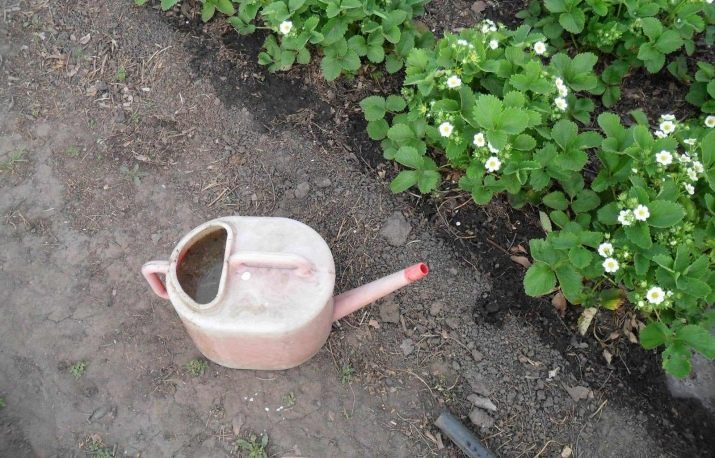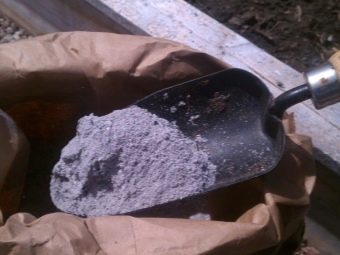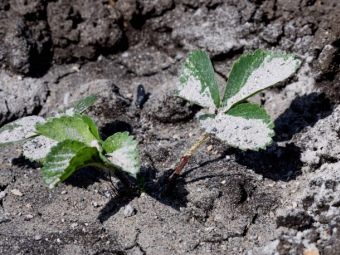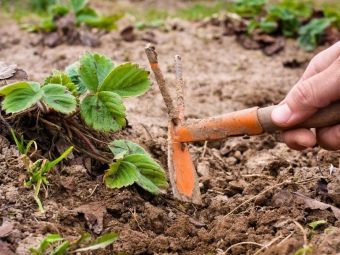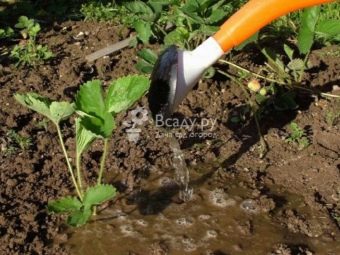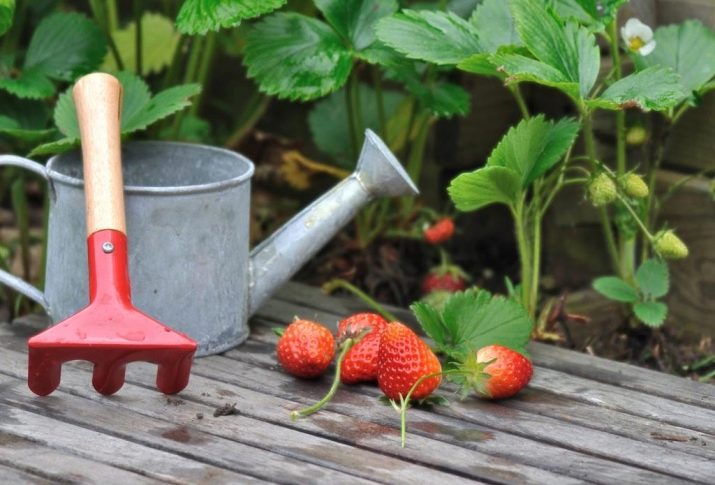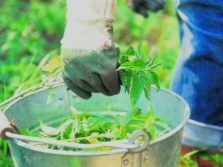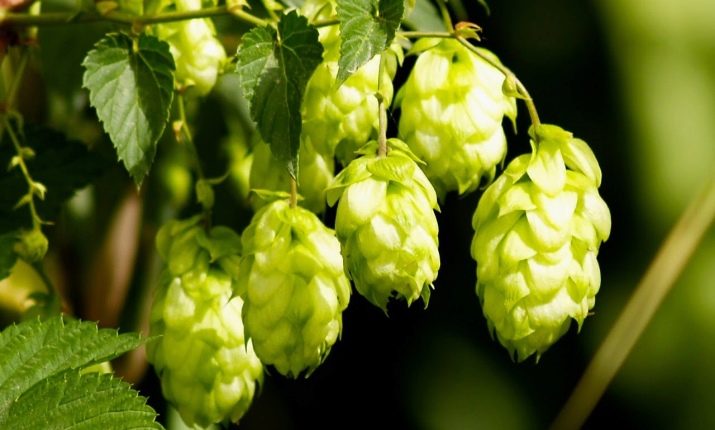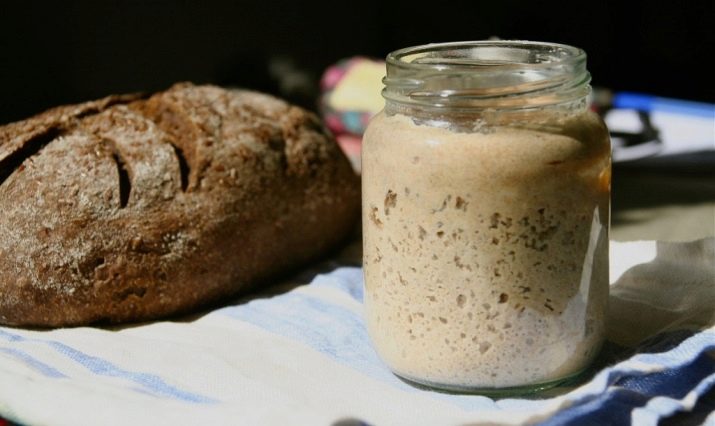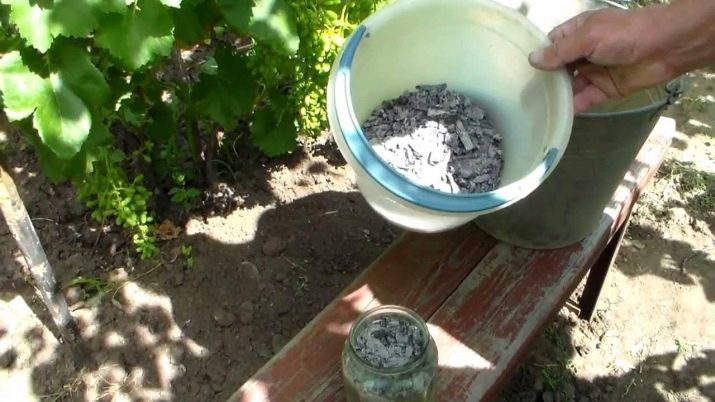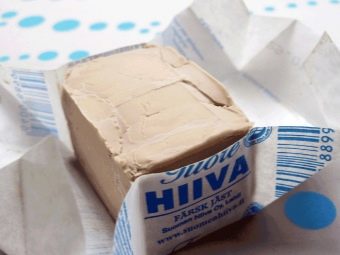Feeding strawberries with yeast: how to use and prepare the product correctly?
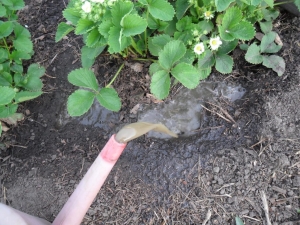
Strawberry is one of the most popular garden crops, this berry can be found at every summer cottage of our compatriots. However, it is not at all easy to get a good harvest, the tender fruits are attacked by recurrent frosts, diseases and pests. To make the plant more durable and strong, you must use dressings, among which the usual yeast is considered the most effective fertilizer.
The composition of the tools and reasons for use
Yeast is an excellent alternative to all industrial means for fertilizing fruit crops, yeast tincture actively nourishes the plant and causes its enhanced growth. The substance includes proteins, fats and essential carbohydrates, is rich in phosphorus, calcium, iodine, potassium, copper, thiamine and B vitamins, and also important for building green mass nitrogen.
It is safe to say that yeast is a real finished product, the structure of which includes all macro- and microelements required for full growth and development of the plant. Yeast tincture is used for root feeding, and for spraying leaf plates, and you can take both pressed live yeast and dry packaged bakeries.
If you study the finished products presented on the shelves of summer residents, you can see that the composition of mineral components is almost identical to the composition of yeast - in this situation it makes no sense to overpay, and yeast processing is much more environmentally friendly and safer.
Strawberry fertilizer with yeast has a whole range of beneficial effects:
- causes the active growth of leaf mass of plants;
- improves the condition and dimensions of the roots;
- enhances plant immunity, with the result that strawberries are much less common;
- increases the number of ovaries, and this, in turn, leads to an increase in yield as a whole;
- bacteria, represented in yeast, effectively suppress pathogens that can be found in the ground;
- Once in the soil, the yeast begins to actively proliferate, which releases a significant amount of nitrogen and phosphorus in a form that is easily digestible by the plant.
However, one should not forget that garden strawberries tend to completely remove nutrients from the ground, therefore, after a yeast top-dressing, it is imperative to pollinate the ground with chopped wood ash.
Terms and conditions of fertilization
The idea of yeast as a useful fertilizer for strawberries came from ancient times, while this method is attributed to folk, however, its effectiveness is not in doubt. That is why experienced gardeners with a clear conscience recommend using this tool throughout the growing season.
Strawberries should be fertilized with yeast infusion three times. Stable warm weather is an indispensable condition, since at low temperatures the fungi will simply not work for the good of the plant. In order to process a dozen adult bushes, it will take about 5 liters of fertilizer, and the incoming mineral substances will last for two months. The first dressing should be carried out in spring at the stage of bud formation, the second - at the moment of fruiting, and the last - after harvesting.
As soon as the snow melts, it is necessary to start properly preparing the land in the open area for the new season. At this point, the plants wake up and they need vitality in order to grow and get stronger. To do this, you need to pull out all the weeds, loosen the soil qualitatively and add yeast starter, then the plant will be able to increase the green mass as soon as possible and prepare for the next stage - flowering. It was noted that if in May there are recurrent frosts, then the bushes, previously fertilized with yeast, are much easier to tolerate a temporary lowering of the temperature background.
The second yeast dressing is necessary during active fruiting, immediately after the green fruits are formed.The introduction of such fertilizer will speed up the ripening of berries and increase their size. Along the way, you should water the strawberries well, since water is necessary for their normal growth and ripening. If we neglect these agrotechnical manipulations, the shrubs will quickly turn into wild plants, the yield of which leaves much to be desired.
The third dressing is carried out after harvesting the entire crop. Usually, gardeners mow all the foliage, but this is a big mistake, because it can damage the core of the bush and the growing point, which leads to lower yields in subsequent periods. The plant should certainly spend the winter along with foliage, but what must be done is to feed it with potassium and phosphorus, which are abundantly represented in yeast. Thanks to these microelements, the growth of new roots and the formation of flower buds are stimulated, and strawberries will be in great demand next year.
These dressings are attributed to the root - the resulting solution is poured into the ground under the bush, and irrigates the rows. But the scope of the use of yeast does not end there - a foliar dressing showed a very high efficiency, which is carried out by spraying the sheet plates with the prepared solution. This dressing is also carried out three times during the growing season.
Yeast is often used for effective rooting of cuttings, it has long been noted that these fertilizers stimulate rooting of rosettes, so shortly before planting the cuttings should be placed in the infusion of live yeast for 20-25 hours, and then kept in water. Such processing allows the strawberry to quickly build a strong and viable root system.
Important: if it is noticed that light spots have appeared on the leaf plates, this indicates that the yeast infusion has completely washed calcium from the soil. In this situation, it is better to stop feeding.
Popular cooking recipes
There are quite a few ways to prepare yeast infusions, but in any case, the principle of their action is common - during fermentation all microorganisms become active and therefore the processes of their vital activity in the earth are accompanied by the release of micronutrients in the earth.
The following yeast based solutions are used most often.
- A kilogram of live yeast and 2 tablespoons of sugar is diluted in 5 liters of heated water, allowed to brew for 2 hours (during this time the fermentation process starts). Before watering, the initial infusion is filled with water up to 50 liters and fertilized in the amount of 1 liter per bush.
- 1 kilogram of live yeast is dissolved in half a bucket of water, heated to 23-26 degrees, then closed with a tight lid and placed in a warm place for 4-5 days. After that, the fermented solution is brought with water to the desired consistency (14 liters of warm water per 1 liter of the base solution) and poured half a gallon into each bush under the bushes.
- You can take and soluble yeast. To do this, 1 package of Saf-moment is mixed with 2 tablespoons of refined sugar and diluted with all this in 0.3 l of water heated to 35 degrees. After that, tightly closed and allowed to ferment in a warm place for 36 hours. The resulting composition is diluted to 10 liters with water, the resulting concentrate is obtained. For efficient feeding, 1 liter of concentrate is poured into a bucket of water, stirred and watered - at the rate of half a liter of composition per plant.
- Weed grasses, especially nettle, wormwood and wheat grass are considered to be the ideal fertilizer for garden strawberries. They are made fertilizer for strawberries - herbs are crushed and poured with warm water from a ratio of 1 bucket of greens to 50 liters of water. After that, add 500 g of live (not dry) yeast to the resulting infusion, a loaf of stale bread and put it all together for 3-5 days for fermentation. This solution is popular with gardeners, because it allows you to feed the plant with all the necessary micro-and macro-elements.
It should be borne in mind that the prepared fertilizer solution must be warm, otherwise its efficiency will be minimal or not felt at all.
If there is no opportunity to purchase yeast in the store, do not despair. You can always make good analogs of yeast starter, which, by the degree of impact on planting, are in no way inferior to purchased yeast.
To do this, the usual hops, which adorns most of the fences and walls in the cottages. To be more precise, his bumps will be needed. One glass of raw materials should be poured with a liter of boiling water and boil over 60 minutes over low heat. After that, the composition should be allowed to cool, and then strain through a sieve. To the resulting concentrate enter 2 tablespoons of sugar and flour and put in a warm place for 2 days. At the end of this period, two finely grated potatoes or sliced potato peelings should be added to the container and left to stand for another one or two days.
Such a composition before use diluted with ordinary water from a ratio of 1 cup of yeast to 10 liters of water.
If there are no hops, then you can make a sourdough on the basis of wheat. To do this, its grain should be germinated and then crushed. After that, 2 tablespoons of sugar and flour are introduced into 1 cup of the resulting mixture - a creamy consistency should form. The resulting mass must be placed on the stove and boil on low heat for about 15-20 minutes, then turn off the burner and leave the broth for 24 hours to ferment. As soon as active processes begin, the mixture should be diluted in one bucket of water and watered strawberries with this solution.
Common mistakes
Yeast top dressing gives a visible result after a few days, so many gardeners make a common mistake starting to make such fertilizer too often. To do this is wrong - strawberries are enough for three treatments in one growing season. Additional dressing is allowed when transplanting bushes and in the case when the plant begins to wither.
It is important that fertilizing is carried out only in warm weather. Everything is simple here - any housewife knows well that the yeast fungus is activated exclusively in a warm environment, therefore when applying fertilizers to cold soil, the effect of the infusion will be expressed rather weakly.
The yeast at the fermentation stage quite intensively absorbs potassium and calcium, so the earth becomes poor on these substances, which has the most disastrous effect on the condition of strawberry bushes. To avoid adverse effects, after each fertilizer, wood ash should be added to the ground - it can be added by pollination, or an ash extract can be prepared, the result was the same in any case.
Opinion gardeners on the application
Absolutely all gardeners give positive feedback on the use of yeast dressings on a strawberry bed. It is noted that after using such fertilizers, the plants become stronger, stronger and more powerful, they have more peduncles, and the harvest becomes much richer compared to strawberries, which are not fed. At the same time, the taste properties of the berries are noticeably higher - they are juicier and sweeter. In addition, the strawberry treated with yeast extract allows the plant to better tolerate return frost and pest invasion.
The composition attracts gardeners by the fact that it can be prepared on its own from available components - yeast and sugar, which can be purchased at any store, and the cost of yeast, both dry and fresh, is really "cheap" - weed fertilizer will cost no more than 50 rubles.
Of course, yeast can not be a panacea, however, they can significantly improve the condition of strawberry bushes and get a rich harvest of juicy, fragrant and mouth-watering berries.
About feeding strawberries with yeast, see the following video.

